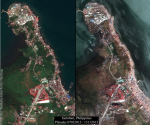Friday, November 15th, 2013
A new scientific study has identified the protected areas most critical to preventing extinctions of the world’s mammals, birds and amphibians. Resulting from an international collaboration, this analysis provides practical advice for improving the effectiveness of protected areas in conserving global biodiversity.
Friday, November 15th, 2013
New hydrological details of the 2010 flood that killed 20 people in and near the Albert Pike Recreation Area were released today in two U.S. Geological Survey reports.
Friday, November 15th, 2013
A new study based on Earth-observing satellite data comprehensively describes changes in the world’s forests from the beginning of this century. Published in Science today, this unparalleled survey of global forests tracked forest loss and gain at the spatial granularity of an area covered by a baseball diamond (30-meter resolution).
Friday, November 15th, 2013
Free and open access to Sentinel satellite data will be granted for the Copernicus operational phase. The European Delegated Act on Copernicus data and information policy will enter into force in the coming days. This Act provides free, full and open access to users of environmental data from the Copernicus programme, including data from the
Thursday, November 14th, 2013
A new study based on Earth-observing satellite data comprehensively describes changes in the world’s forests from the beginning of this century. Published in Science today, this unparalleled survey of global forests tracked forest loss and gain at the spatial granularity of an area covered by a baseball diamond (30-meter resolution).
Thursday, November 14th, 2013
The USGS, in cooperation with other Federal agencies, has posted new Ohio US Topo quadrangles (748 maps) which include partial Public Land Survey System (PLSS). Ohio is the first state east of the Mississippi River to have PLSS data added to US Topo maps, joining Wyoming and Colorado in the west.
Thursday, November 14th, 2013
USGS scientists have determined that high-salinity groundwater found more than 1,000 meters (0.6 mi.) deep under the Chesapeake Bay is actually remnant water from the Early Cretaceous North Atlantic Sea and is probably 100-145 million years old. This is the oldest sizeable body of seawater to be identified worldwide.

Thursday, November 14th, 2013
The effects of Typhoon Haiyan, which hit the Philippines on November 8 2013, were photographed on 13 November 2013 by a Pléiades satellite, which had captured images of the same zone (Tacloban) on 7 March 2013.
Thursday, November 14th, 2013
URISA is pleased to announce that Ryan Elizabeth Bowe, GISP has been named URISA’s Young Professional of the Year in recognition of her outstanding efforts as part of URISA’s Vanguard Cabinet. Since 2005, Ryan has worked as a GIS Technician at Photo Science, Inc. – A Quantum Spatial Company, in Lexington, Kentucky. She is a
Thursday, November 14th, 2013
New research by the U.S. Geological Survey conducted on the Delmarva Peninsula, which forms the Eastern Shore of the Chesapeake Bay, indicates it may take several decades for many water-quality management practices aimed at reducing nitrogen input to the Bay to achieve their full benefit due to the influence of groundwater.